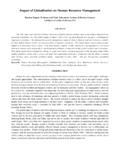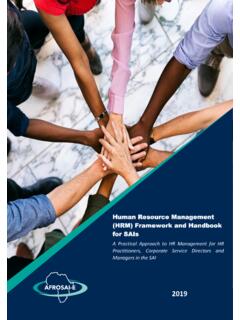Transcription of PART I Introduction to Human Resource Management and …
1 IntroductiontoHumanResourceManagementand HumanResourceInformationSystems PPAARRTT II11 Evolution ofHuman ResourceManagement andHuman ResourceInformationSystemsThe Role of information TechnologyMohan ThiteMichael J. Kavanagh EDITORS NOTEThe purpose of thi s chapter is to provide an introductio n to the fields of humanresource Management (HRM)and information techno logy (I T), and the com -bination of these two fields into Human Resource information systems(HRIS). T he fi rst chapter will lay the groundwork f or the r emainder of this book, 3 VIGNETTET here are numerous feder al and state laws and regulations regarding the treatment ofemp loyees, as will be discusse d thro ughout this book. For example, some of these lawsregulate the numbe r of working hours in a week and overtime re quirements, union-man agement relations, and u nfair discrimination in the personnel practices of a fir m.
2 Onesuch la w, Title VII of the Civi l Rights Law of 1964 as amended by the E qual OpportunityAct of 19 72, protects ind ivid uals against unfair discrimination based o n race, national ori-gin, and gender in any personnel decision for example, hiring. This law protecting therigh ts of indi viduals is generally referre d to as EEqquuaall EEmmppllooyymmeenntt OOppppoorrttuunniittyy((EEEEOO))leg -islation. To determine if organizatio ns are c om plyi ng with this l aw, all companies mustcomplete an annual report for the federal government, cal led the EEO-1 report. This repor tdescribes the composition of the wor k f orce by job in terms of gender, race, and nationalori gin (see Chapter 9). This rep ort is often referred to as an EEO or Affirmati ve ActionAudit. The important poin t is that t he empl oyees must be categorized into jobs, and thenand as such, it is important to thoroughly understand the concepts and ideas in thischapter.
3 This chapter contains definitions for a number of terms in common use inthe HRM, I T, and HRIS fields and will emphasize the maj or underlying themes ofthis book. F in all y, an overview of the entire book will be covered, showing h oweach chapter is an integral part of the entire field of Introduction TO HRM AND HRISCHAPTER OBJECTIVESA fter completing this chapter, you should be able to Describe the historical evolution of HRM, including the changing role of thehuman resources (HR) professional Discuss the impact of computer technology on the evolution of HRM Describe the three types of HR activities Explain the relationship between strategic HRM and HRIS Explain the purpose and nature of HRIS as well as the differences betweenthe types of HRIS Discuss the use of information from an HRIS in decision making Describe the central themes of the book and how they relate to manager-ial decision making Understand how HRM and HRIS fit into a comprehensive model of orga -nizational functioningthe n umber and percentage distributions of racial, gender, and national o rigin of employ -ees must be dete regional distributor and service center for a national a ppli ance compan y w ith 300 employees had to complete all annual government reports on employees for the pre-viou s year by January 31.
4 All the employee records were in paper files. The Director ofHum an Resources indicated that the compliance with the EEO l aws in terms of complet-ing the EEO-1 report to ok one full-time HR employee worki ng for 1 month to completethe report. The lengthy time tak en to complete the report was due to the fact that theemployee records had to be searche d each year since there were new hi ring, promotions,terminations, and other turnover dur ing the year. After this company acq ui red HRIS soft-ware for all governmen t r epo rts , it only took about 4 hours to complete the EEO-1 company example illustrates one important advantage of conversion to anHRIS from a paper-based syst em re duction of st aff time on reports. I t should be noted ,however, that accuracy of reports is s till a concern, and accuracy of emplo yee records isdetermined main ly from the correct inputting of employee data for the softwareprograms.
5 It is also importan t t o not e that the cost savings of reducing staff time togen erate the report is not th e only be nefi t from adoption of computer-based HR soft-ware. As will be discussed later in this chapter, the ti me saving means that the HR pro-fessional can be assigned to other, more important tasks for the company. Thesecha racteristics of an HRIS speed and accuracy will be emphasized throughout thisbook as the majo r advantage of an Management thinkers suggest that it i s not technology, bu t the art of Human -and humane- Management that is the c ontinu ing challenge for execut ives in the21st century (Drucker, Dyson, Handy, Saffo, & Senge, 1997 ). Simi la rly, Smith and Kelly(1997) believe that future economic and strategi c advantage will rest with the orga-nizations that can most effectively attract, develop and retain a diverse group of thebest and the b rightest Human tal en t in the ma rket place (p.)
6 200).In general, to maintain a competitiv e advantage in the marketplace, fi rm s need tobala nce the resources available to th e firm to achi eve the desired results of profitabili-ty and survival. The resourc es that are available to the fi rm fa ll in to three generalcategories: physical, organizational, and Human . In discus sing how to gai n a competi -tive advantage in the global market, Porter (199 0) noted that Management of thehuman r esources is the most critical of the three. The idea of treating Human resourcesas a means of gaining a competitive advantage in both the domestic and the globalmarketplace has b een echoed by other authors. As Greer (1995) states,In a growing number of o rganizations Human resources are now viewed as a source ofcompetitive advantage. T here is greater recognition that distinctive competencies areobtained through highly developed employee skills, distinctive organizational cultures,Chapter 1 Evolution of HRM and HRIS 5management processe s, and systems.
7 This is in contrast to the traditional emphasis ontransferable resources such as reasingly, it is being recognized that com-peti tive advantage can be obtained with a high quality work force that enables organiz a-tions to compete on the basis of market responsiveness, product and se rv ice quality,differentiated products, and technological innovation. (p. 105)The effective Management of Human resources in a firm to gain a competit iveadvantage in the market pl ace requires t imely and accurate in formationon currentemploye es and potential employees i n the labor market. With the evolution of com-puter technology, meeting this inf ormation requirement has been gre atly en hancedth rough the creation of HRIS. A basi c assumption behind this book is that the man -agement of employee information will be the critical process that helps a firm maximizeth e use of its huma n resources and main tai n competit iveness in its firs t purpose of th is book is to provide information on the development, imple-mentation, and maintenanceof an HRIS.
8 The seco nd purpose is to demonstrate how anHRIS can be used in HRM progr ams, such as selecting and training employees, to maketh em more efficient and ef fective. The final purpose i s to prov ide an opportunity for youto apply your knowledge th rough the analysis of the cases at the e nd of each torical Evolution of HRM and HRISOne can analyz e the historical trends o f the HR functi on from di ffe rent viewpoints :th e evolution of HRM as a professional and scientific dis cipline, as an a id to manage -ment, as a polit ic al an d economic co nflict between Management and employees, andas a growing movement of employee involvement influenced by developments inindustrial/organizational and social psyc hology. This hi st orical analysis will demon-strate t he growing importance o f employees from being just one of the means of pro-duction i n the 2 0th-century industrial economy to being a key source of sustainablecompetitiv e advantage in the 21st-century kno wledge e t his is a book on HRIS, we will examine the development of the fields ofbot h HR and IT in terms of their evolution since the early 20th century.
9 This meansexamining the ev ol ution of HRM intert wined with developments in IT and des cribingho w IT has played an increasing role in the HRM function. In addition, this hi storicalanalysis wil l s how how the role of HRM in the firm has changed ove r ti me fromprimarily b eing concerned with rout ine transact io nal HRac tivi ties to dea li ng withcomplex trans formational ones. Transactional act ivities are the routine bookkeepingtasks for example, changing an employee s home address or health care provider whereas transformational activitie s are those actions of an organization that addva lue to the consumption o f the firm s product or service. An example of a trans for -mational HRactivity would be a training program for retail clerks to improve cus -tomer service behavior. Thus, transformational activities incr ease the strategicimportance a nd visibility of th e HR function in the firm.
10 This genera l change overtime is illustrated in Figure an d will become evid ent as we tra ce the historical evo-lution of HRM in terms of five broad phases of the histori cal development of indus-tr y in the United States. For more information on this historical development, youshould consult Kavan ag h, Gueut al, and Tannenbaum (1990) or Wa lk er (1982).6 Introduction TO HRM AND HRISPr e W orld War IIIn the early 20th century and prior to World War II, the personnel function (the pre-cursor of t he term Human resou rce Management ) was prim arily involved in record keep-ing of employee information ; in other words, it fulfill ed a caretaker function. Duringthis period of time, the pr eva iling Management philosophy was called scientific man-age ment. The central thrust of sci entific Management was to maximize employee pro-ductivity.











